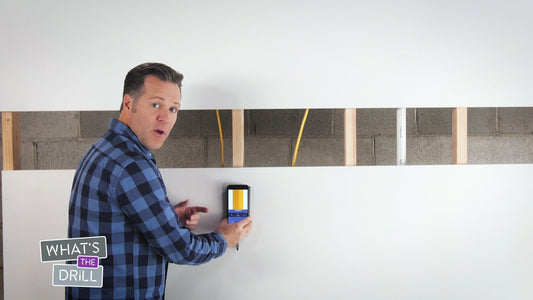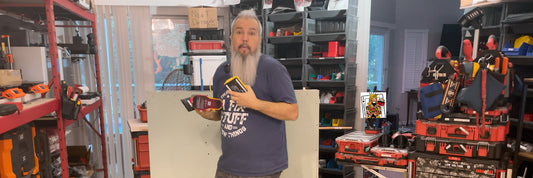Whether you need to hang a heavy picture, put an extra shelf in place, or mount your new TV to the wall, the first step is to find wall studs to support the weight. It might be tempting to skip this step, but as many DIYers have discovered the hard way, drywall anchors leave big holes behind. More than that, drywall, plywood, and other finishing materials alone simply aren’t strong enough to hold heavy objects in place.
With that in mind, here’s your complete guide for how to find wall studs – and prevent disasters along the way!

Using Your Walabot DIY to Find Studs
Let’s start with a simple question. What is a stud? The answer may seem obvious to those with construction experience, but for many of us, a quick explanation can always help.
Basically, studs are part of a building’s frame. And if you’ve ever seen a home, garage, or business before it was completely finished, then it’s likely that you have seen studs in action.
Usually made of 2x4s and sometimes made with larger dimensional lumber or metal, studs provide support and serve as attachment points for other building elements. The painted drywall, trim, and other finishing materials seen inside a building are attached to the studs with nails or screws. Windows and doors have stud frames, and electrical components such as light switches and outlets are typically attached to the sides of studs.
Without studs, these materials would be likely to bow, bend, or even break. In fact, no structure would be able to withstand force or bear loads associated with wind, gravity, and more without the help of studs.
The Best Way to Find Wall Studs
Most of the time, studs are positioned 16 or 24 inches (40.6 or 61 centimeters) “on center” from one another, meaning that there’s a span of either 16 or 24 inches from the center of one stud to the center of the next one. In the days before stud finders, people were forced to measure these distances manually in order to make an educated guess about the location of each stud. Sometimes they would tap the walls and listen for changes in pitch, indicating the approximate location of a stud. There were a few problems with these methods though. For example:
- Trying to find studs without a stud finder can lead to incorrect guesses. Drilling and hammering nails into the wrong location lead to damaged walls, which then need to be repaired.
- Other objects are embedded in walls, so there’s a risk of puncturing a water line, ruining an important cable, or even hitting a live electric wire when you’re not certain where everything is located.
A stud finder then seems like a good solution, but how to use a stud finder? Standard stud finders work by detecting density changes or finding metal screws and/or nails inside walls. These gadgets are better than nothing, but they can provide inaccurate readings caused by objects hung on the wall, even if they’re on the other side of the wall you’re working on. Furthermore, most stud finders don’t tell you what objects they’re detecting.
Put simply, standard stud finder can’t see through walls. But the latest wall scanners, like the Walabot DIY stud finder, are virtually foolproof.
The Walabot DIY wall scanner is a 3D imaging sensor that uses radio frequency technology to show you exactly where studs are located within your wall. This innovative wall scanner can be used on drywall, plywood and OSB walls. It can easily penetrate to depths of 4 inches (10 centimeters) within your wall, to locate different objects and determine what they are made of – metal, plastic or wood.
Using Your Walabot DIY to Find Studs

Now that you know more about the uses of studs and the dangers of not finding them, you’re ready to start your project the right way, with your Walabot DIY in-hand.
To get started with your project, simply pass the Walabot over your work area and locate the number of studs needed to hang your object(s) safely, or complete whatever task you’re doing. Mark the location of the studs with a pencil, and then proceed with your project.
Once you’ve done that you’ll be able to work without worry. Having found the wall studs and determined where to place your fasteners, you can safely hang that picture, add those shelves, or mount that TV with complete confidence.
Of course, there are other uses for the Walabot DIY. Thanks to its ability to eliminate guesswork as to what’s hidden within your walls – from studs to pipes, to wires and more – it can be used to help locate the best position to install lights and fans without damaging ceilings and walls or install network cables.
Having the ability to locate embedded objects speeds up many home improvement tasks while helping prevent costly, unnecessary repairs caused by inaccuracy. Plus, Walabot DIY is budget-friendly and easy to use.
Thanks to its ability to provide real-time imaging, it is ideal for contractors, electricians, plumbers, remodelers, and everyday people who want to make DIY projects easier by finding wall studs and other objects accurately.
Ready to see through walls?




